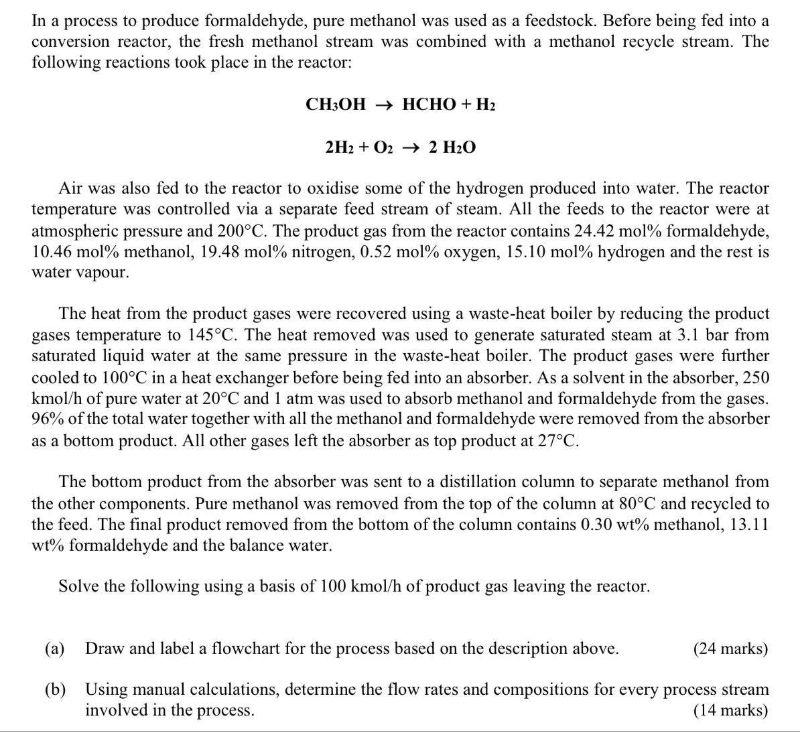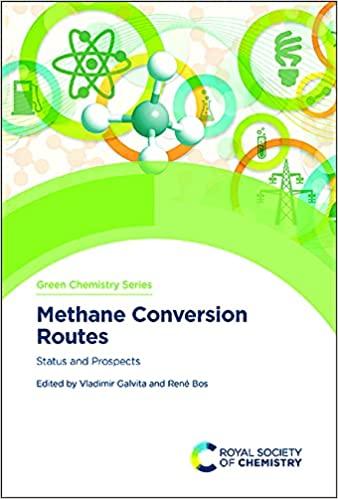

In a process to produce formaldehyde, pure methanol was used as a feedstock. Before being fed into a conversion reactor, the fresh methanol stream was combined with a methanol recycle stream. The following reactions took place in the reactor: CH3OHHCHO+H22H2+O22H2O Air was also fed to the reactor to oxidise some of the hydrogen produced into water. The reactor temperature was controlled via a separate feed stream of steam. All the feeds to the reactor were at atmospheric pressure and 200C. The product gas from the reactor contains 24.42mol% formaldehyde, 10.46mol% methanol, 19.48mol% nitrogen, 0.52mol% oxygen, 15.10 mol % hydrogen and the rest is water vapour. The heat from the product gases were recovered using a waste-heat boiler by reducing the product gases temperature to 145C. The heat removed was used to generate saturated steam at 3.1 bar from saturated liquid water at the same pressure in the waste-heat boiler. The product gases were further cooled to 100C in a heat exchanger before being fed into an absorber. As a solvent in the absorber, 250 kmol/h of pure water at 20C and 1atm was used to absorb methanol and formaldehyde from the gases. 96% of the total water together with all the methanol and formaldehyde were removed from the absorber as a bottom product. All other gases left the absorber as top product at 27C. The bottom product from the absorber was sent to a distillation column to separate methanol from the other components. Pure methanol was removed from the top of the column at 80C and recycled to the feed. The final product removed from the bottom of the column contains 0.30wt% methanol, 13.11 wt% formaldehyde and the balance water. Solve the following using a basis of 100kmol/h of product gas leaving the reactor. (a) Draw and label a flowchart for the process based on the description above. (24 marks) (b) Using manual calculations, determine the flow rates and compositions for every process stream involved in the process. (14 marks) (c) Compare and discuss the single-pass conversion and overall conversion of methanol. Also, determine the conversion of oxygen in the reactor. ( 6 marks) (d) Determine the recovery of methanol in the distillation column that was recycled to the feed. ( 2 marks) (e) Calculate the molar flow rates and compositions of the fresh feed and recycle stream to achieve a formaldehyde production rate of 1500kg/h. (4 marks) In a process to produce formaldehyde, pure methanol was used as a feedstock. Before being fed into a conversion reactor, the fresh methanol stream was combined with a methanol recycle stream. The following reactions took place in the reactor: CH3OHHCHO+H22H2+O22H2O Air was also fed to the reactor to oxidise some of the hydrogen produced into water. The reactor temperature was controlled via a separate feed stream of steam. All the feeds to the reactor were at atmospheric pressure and 200C. The product gas from the reactor contains 24.42mol% formaldehyde, 10.46mol% methanol, 19.48mol% nitrogen, 0.52mol% oxygen, 15.10 mol % hydrogen and the rest is water vapour. The heat from the product gases were recovered using a waste-heat boiler by reducing the product gases temperature to 145C. The heat removed was used to generate saturated steam at 3.1 bar from saturated liquid water at the same pressure in the waste-heat boiler. The product gases were further cooled to 100C in a heat exchanger before being fed into an absorber. As a solvent in the absorber, 250 kmol/h of pure water at 20C and 1atm was used to absorb methanol and formaldehyde from the gases. 96% of the total water together with all the methanol and formaldehyde were removed from the absorber as a bottom product. All other gases left the absorber as top product at 27C. The bottom product from the absorber was sent to a distillation column to separate methanol from the other components. Pure methanol was removed from the top of the column at 80C and recycled to the feed. The final product removed from the bottom of the column contains 0.30wt% methanol, 13.11 wt% formaldehyde and the balance water. Solve the following using a basis of 100kmol/h of product gas leaving the reactor. (a) Draw and label a flowchart for the process based on the description above. (24 marks) (b) Using manual calculations, determine the flow rates and compositions for every process stream involved in the process. (14 marks) (c) Compare and discuss the single-pass conversion and overall conversion of methanol. Also, determine the conversion of oxygen in the reactor. ( 6 marks) (d) Determine the recovery of methanol in the distillation column that was recycled to the feed. ( 2 marks) (e) Calculate the molar flow rates and compositions of the fresh feed and recycle stream to achieve a formaldehyde production rate of 1500kg/h. (4 marks)








